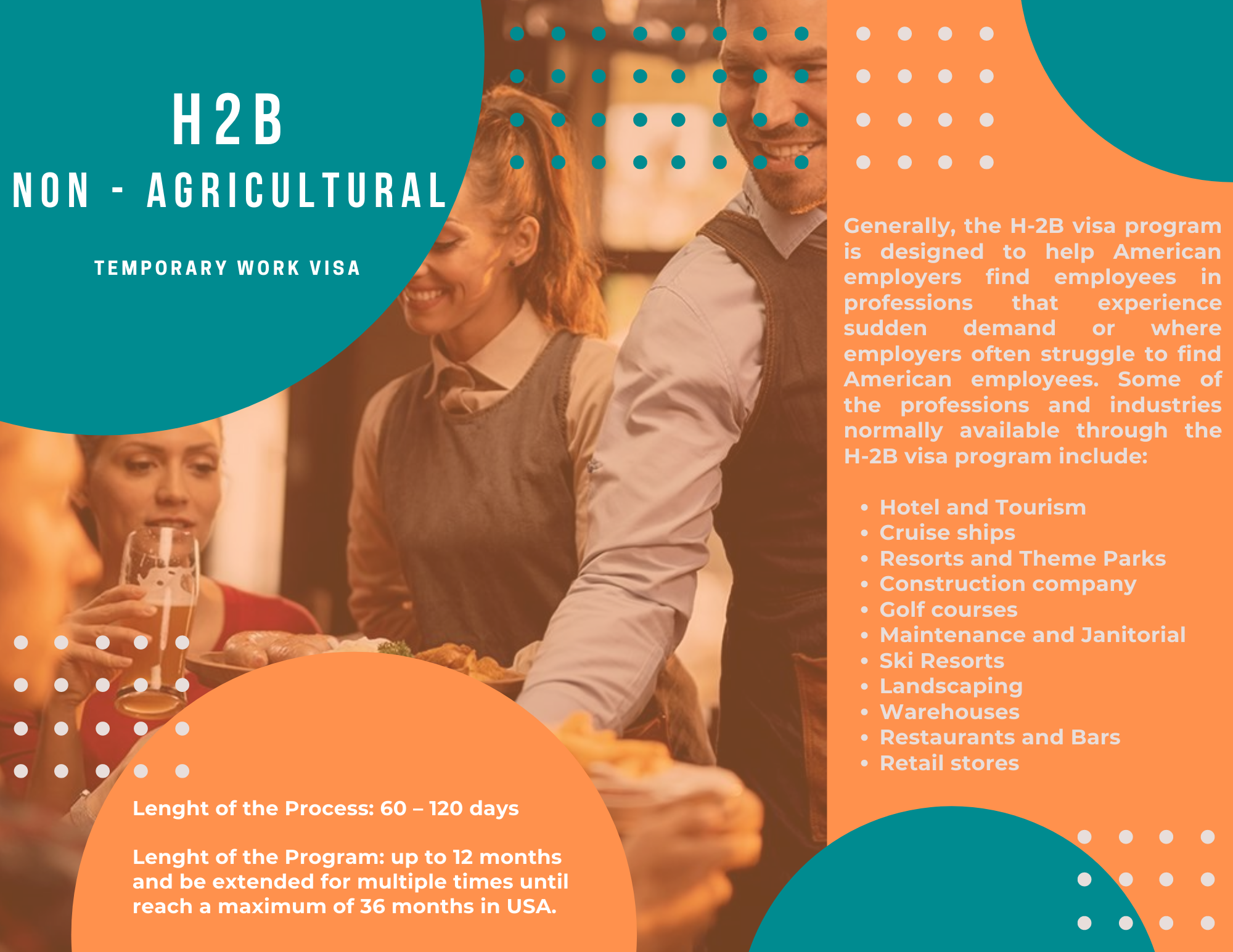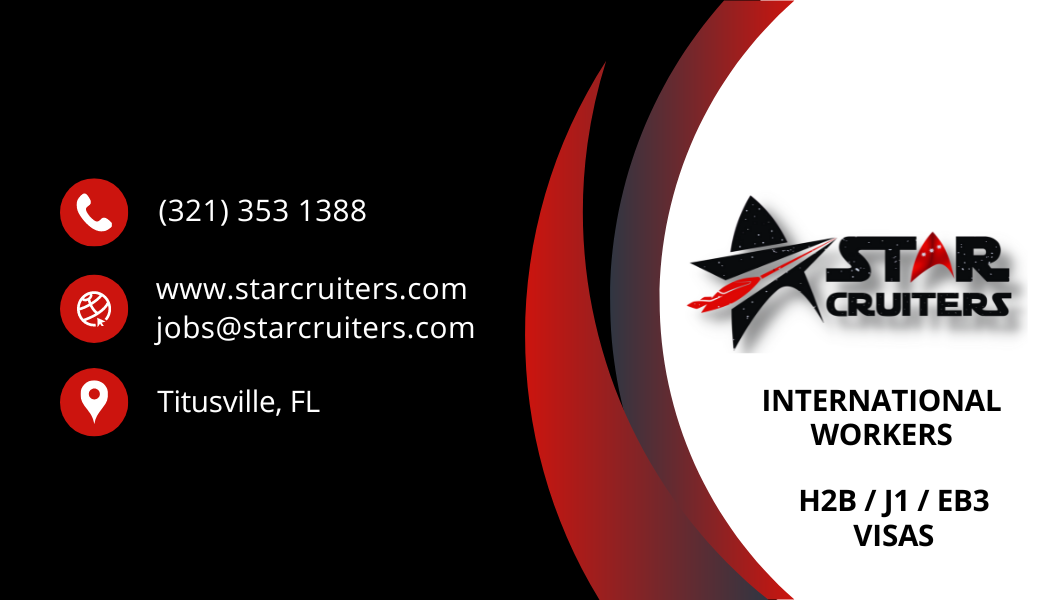H2B - Non AGRICULTURAL

To qualify for H-2B nonimmigrant classification, the petitioner must establish that:
- There are not enough U.S. workers who are able, willing, qualified, and available to do the temporary work.
- Employing H-2B workers will not adversely affect the wages and working conditions of similarly employed U.S. workers.
- Its need for the prospective worker’s services or labor is temporary, regardless of whether the underlying job can be described as temporary. The employer’s need is considered temporary if it is a(n):
- One-time occurrence – A petitioner claiming a one-time occurrence must show that it has:
- An employment situation that is otherwise permanent, but a temporary event of short duration has created the need for a temporary worker.
- Not employed workers to perform the service or labor in the past, and will not need workers to perform the services or labor in the future;
OR
- Seasonal need – A petitioner claiming a seasonal need must show that the service or labor for which it seeks workers is:
- Traditionally tied to a season of the year by an event or pattern; and
- Of a recurring nature.
Note: You cannot claim a seasonal need if the time period when you do NOT need the service or labor is:
- Unpredictable;
- Subject to change; or
- Considered a vacation period for your permanent employees.
OR
- Peak load need – A petitioner claiming a peak load need must show that it:
- Regularly employs permanent workers to perform the services or labor at the place of employment;
- Needs to temporarily supplement its permanent staff at the place of employment due to a seasonal or short-term demand; and
- The temporary additions to staff will not become part of the employer's regular operation.
OR
- Intermittent need – A petitioner claiming an intermittent need must show that it:
- Has not employed permanent or full-time workers to perform the services or labor; and
- Occasionally or intermittently needs temporary workers to perform services or labor for short periods.
H-2B petitioners must also provide a single valid temporary labor certification from the U.S. Department of Labor (DOL), or, if the workers will be employed on Guam, from the Guam Department of Labor (Guam DOL).
H-2B Program Process
- Step 1: Petitioner submits temporary labor certification application to DOL. Before requesting H-2B classification from USCIS, the petitioner must apply for and receive a temporary labor certification for H-2B workers with the U.S. Department of Labor (or Guam DOL if the employment will be in Guam).* For further information regarding the temporary labor certification application requirements and process, see the Foreign Labor Certification, Department of Labor and Foreign Labor Certification, Guam Department of Labor Web pages.
- Step 2: Petitioner submits Form I-129 to USCIS. After receiving a temporary labor certification for H-2B employment from either DOL or Guam DOL (if applicable), the petitioner must file Form I-129 with USCIS. With limited exceptions, the petitioner must submit the original temporary labor certification with Form I-129 (See the Form I-129 instructions for additional filing requirements). If the application for a temporary labor certification was processed in DOL’s FLAG system, the petitioner must include a printed copy of the electronic one-page “final determination” of the H-2B temporary labor certification approval with Form I-129. USCIS will consider a printed copy of the final determination as the original and approved temporary labor certification. If a petitioner has already submitted the original temporary labor certification with a previous Form I-129, submit a copy of the temporary labor certification and provide an explanation that includes the receipt number of the petition with which the original was filed, if available.
- Step 3: Prospective workers outside the United States apply for visa and/or admission. After USCIS approved Form I-129, prospective H-2B workers who are outside the United States must:
- Apply for an H-2B visa with the U.S. Department of State (DOS) at a U.S. Embassy or Consulate abroad and then seek admission to the United States with U.S. Customs and Border Protection (CBP) at a U.S. port of entry; or
- Directly seek admission to the United States in H-2B classification with CBP at a U.S. port of entry in cases where an H-2B visa is not required.
*Note: If you are petitioning for one or more Canadian musicians that will be employed within a 50 mile radius from the U.S.-Canadian border for 30 days or less, you may skip Step 1 in the H-2B process.
- Step 1: Petitioner submits temporary labor certification application to DOL. Before requesting H-2B classification from USCIS, the petitioner must apply for and receive a temporary labor certification for H-2B workers with the U.S. Department of Labor (or Guam DOL if the employment will be in Guam).* For further information regarding the temporary labor certification application requirements and process, see the Foreign Labor Certification, Department of Labor and Foreign Labor Certification, Guam Department of Labor Web pages.
- Step 2: Petitioner submits Form I-129 to USCIS. After receiving a temporary labor certification for H-2B employment from either DOL or Guam DOL (if applicable), the petitioner must file Form I-129 with USCIS. With limited exceptions, the petitioner must submit the original temporary labor certification with Form I-129 (See the Form I-129 instructions for additional filing requirements). If the application for a temporary labor certification was processed in DOL’s FLAG system, the petitioner must include a printed copy of the electronic one-page “final determination” of the H-2B temporary labor certification approval with Form I-129. USCIS will consider a printed copy of the final determination as the original and approved temporary labor certification. If a petitioner has already submitted the original temporary labor certification with a previous Form I-129, submit a copy of the temporary labor certification and provide an explanation that includes the receipt number of the petition with which the original was filed, if available.
- Step 3: Prospective workers outside the United States apply for visa and/or admission. After USCIS approved Form I-129, prospective H-2B workers who are outside the United States must:
- Apply for an H-2B visa with the U.S. Department of State (DOS) at a U.S. Embassy or Consulate abroad and then seek admission to the United States with U.S. Customs and Border Protection (CBP) at a U.S. port of entry; or
- Directly seek admission to the United States in H-2B classification with CBP at a U.S. port of entry in cases where an H-2B visa is not required.
*Note: If you are petitioning for one or more Canadian musicians that will be employed within a 50 mile radius from the U.S.-Canadian border for 30 days or less, you may skip Step 1 in the H-2B process.
Period Of Stay
Generally, USCIS may grant H-2B classification for up to the period of time authorized on the temporary labor certification. H-2B classification may be extended for qualifying employment in increments of up to 1 year each. A new, valid temporary labor certification covering the requested time must accompany each extension request. The maximum period of stay in H-2B classification is 3 years.
A person who has held H-2B nonimmigrant status for a total of 3 years must depart and remain outside the United States for an uninterrupted period of 3 months before seeking readmission as an H-2B nonimmigrant. Additionally, previous time spent in other H or L classifications counts toward total H-2B time.
Exception: Certain periods of time spent outside of the United States may "interrupt" an H-2B worker's authorized stay and not count toward the 3-year limit. See the Calculating Interrupted Stay for H-2 Classifications Web page for additional information.
Generally, USCIS may grant H-2B classification for up to the period of time authorized on the temporary labor certification. H-2B classification may be extended for qualifying employment in increments of up to 1 year each. A new, valid temporary labor certification covering the requested time must accompany each extension request. The maximum period of stay in H-2B classification is 3 years.
A person who has held H-2B nonimmigrant status for a total of 3 years must depart and remain outside the United States for an uninterrupted period of 3 months before seeking readmission as an H-2B nonimmigrant. Additionally, previous time spent in other H or L classifications counts toward total H-2B time.
Exception: Certain periods of time spent outside of the United States may "interrupt" an H-2B worker's authorized stay and not count toward the 3-year limit. See the Calculating Interrupted Stay for H-2 Classifications Web page for additional information.
Family of H-2B Workers
Any H-2B worker's spouse and unmarried children under 21 years of age may seek admission in H-4 nonimmigrant classification. Family members are not eligible for employment in the United States while in H-4 status.















